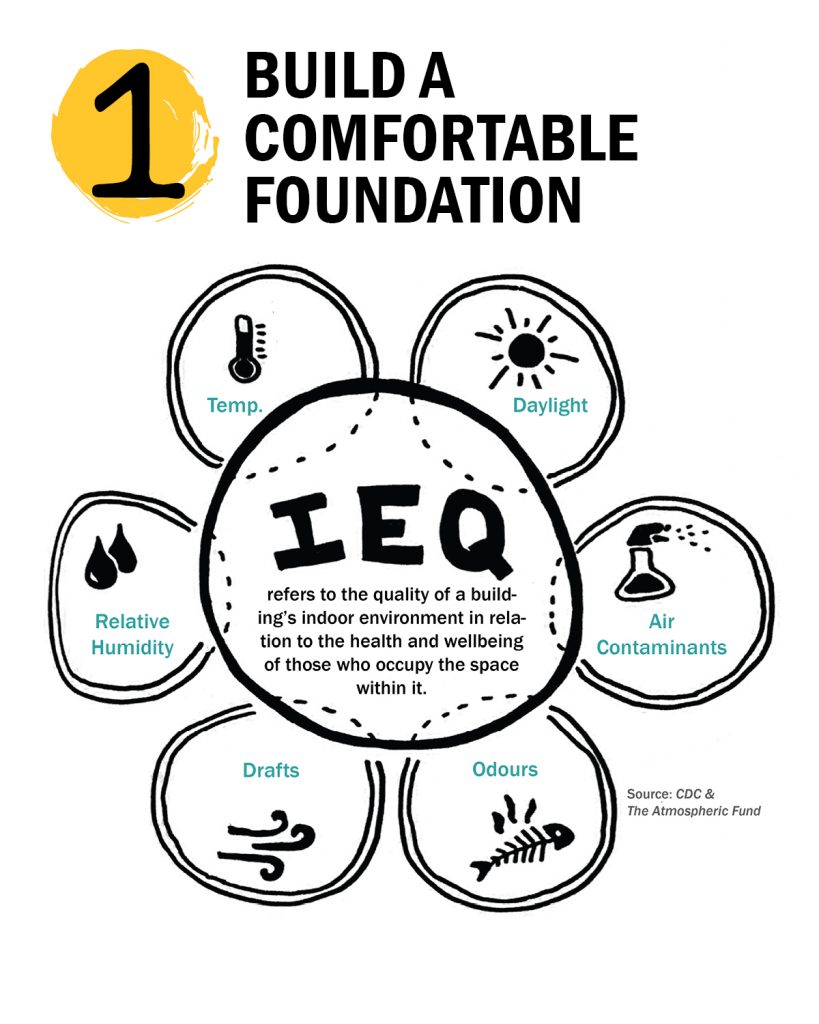The Perkins Eastman Design Strategy team shares three ideas on how to create a better home base for hybrid workers.
If you have an office job in post-pandemic times, there’s a good chance you’re familiar with the concept of free address seating. You might even be “free addressing” at this very moment. The adoption of this space-saving model, where desks in the office are unassigned, has grown to a scale that would have been unimaginable several years ago. According CBRE’s Spring 2023 Office Occupier Sentiment Survey, only 25% of corporate real estate executives said they plan to keep a 1-to-1 seating ratio in the office, while 67% are targeting a 2-to-1 or even 3-to-1 employee to seat ratio.
If hybrid work continues at its current level, desk-sharing makes good financial sense; reducing the seat-to-employee ratio usually means significant space (and cost) savings. There are other advantages, too, like freeing up space for amenities, communal areas, and meeting rooms. But desk-sharing comes with challenges for employees, not least of which is losing a “home base” at the office. Companies want workers to rebuild their office habit, but it can be challenging to draw employees back when a desk of their own is no longer on offer.
Someplace Like Home
When we talk about feeling at home, we are talking about psychological safety. This is central to the “home-court advantage” theory, which says that workers have more mental bandwidth to problem-solve and be creative when they feel comfortable, secure, and at ease in their environment.
With this in mind, our Design Strategy team conducted a survey to learn more about what makes people feel at home, i.e. the “hominess” of a space, and how we might improve the employee experience in the shared-desk environments that we design.

An overwhelming majority of survey respondents—86%—said it’s moderately to extremely important for them to feel at home in their office.
If it’s important to feel at home in the office, what are the environmental qualities that contribute to this? And what happens when workers lose their “home base” at the office in the move to free address seating?
Through our research, we identified five pillars of “hominess” and asked survey participants to weigh in on what is most important to them in this regard:
- Physical comfort
- The ability to modify one’s environment
- A sense of privacy
- Familiarity with the space
- Objects of identity (e.g. personal photos, souvenirs, artwork, etc.)

The results of the survey were striking: Physical comfort was, by far, the most important quality. To feel at home, 95% of survey participants said that physical comfort is “very” or “extremely” important. The ability to modify their environment, a sense of privacy, and familiarity with the space tied for a (somewhat distant) second place, while objects of identity came in last.
If physical comfort is paramount, this means that lighting, thermal comfort, ergonomic support, air quality, and acoustics deserve careful consideration. Privacy and the ability to modify the workspace are important, too, but physical comfort could be the piece that allows everything else to fall into place.
Three Strategies to Create a Better Home Base for Hybrid Workers

It’s worth investing in the things that help people feel physically comfortable at work. A good place to start is Indoor Environmental Quality (IEQ), which encompasses things like air quality, thermal comfort, acoustic conditions, lighting, and views. It’s important to think about odors as well; increased moisture content in the air (humidity) is a major offender, as are poorly conceived adjacencies (is that a pantry microwave next to the quiet work zone?). Good IEQ lays a solid foundation for comfort and supports workers’ health, wellbeing, and productivity (in addition to boosting the resale value of a building).

Functional comfort, a concept developed by environmental psychologist Jacqueline Vischer, Ph.D., refers to how the office environment supports work-related tasks and contributes to positive outcomes like performance and teamwork. A Herman Miller survey building on Vischer’s work found that four of five environmental qualities that are “consistent predictors of a ‘high comfort’ workstation” are related to functional comfort:
- The ability to support space for two or more people to meet
- The ability to control interactions with others
- The option to position the computer in the most suitable location
- Having the ability to store personal items
Incorporate these attributes at workpoints throughout the office—especially in shared-desk settings—to increase functionality and comfort.

In the survey that our Design Strategy team conducted, a significant number of participants said that lighting and plants are important to feeling at home. This is good news because it suggests that even the smallest interventions, like improving the task lighting at workstations, orienting desks at a 90-degree angle to windows to reduce glare, or adding greenery or potted plants, could help people feel more comfortable and at home in the office.
Meet The Perkins Eastman Design Strategy Team:
Katie Gluckselig, Senior Design Strategist
Kristina Koch, Senior Design Strategist
Charlotte Bohning, Design Strategist
Hanna Negami Ph.D, Data Strategist
Jinxian Xu, Design Strategist
Want more? Check out these other recent post from the Perkins Eastman Design Strategy team:
How Can Office Design Help To Rebuild Working Relationships?
A Playful Office Doesn’t Have To Look Like a Playground
Are We Losing Sight of How To Build a Better Workplace?


